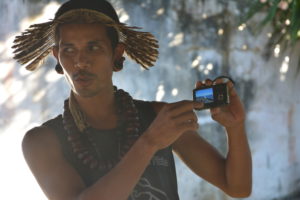
New technologies in traditional communities: How digital media is helping Brazil’s indigenous peoples find their voice
Today Mediático is delighted to present an interview with Sebastián Gerlic, director of the Brazilian NGO Thydêwá by Phoebe Ryan discussing how the organisation works to help re-invigorate and re-empower indigenous communities, encouraging them to assert their rights by means of digital technologies. Phoebe Ryan is a Cumbria-based freelance copywriter who left her heart in Leeds. Following an undergraduate degree at Leeds University’s School of English, she returned to complete a Masters in Postcolonial Literary and Cultural Studies, and worked at Leeds-based publisher Peepal Tree Press. She remains fascinated by new authors from around the world, and nurtures a passion for independent food and drink. [1]
Featured Image: ‘I would say that these days, almost everyone is born a “digital native.” ‘ Young Pataxó girl (Laryssa Machada)
Thydêwá will be presenting their work at the Leeds International Festival (29th April – 12th May 2018), with a film screening and talk on 28th April, plus a photography exhibition and children’s art workshops around the idea of who can be ‘a digital native’. For more information, see the ‘Connected Communities’ listings at: https://leedsinternationalfestival.com/programme/
New technologies in traditional communities: How digital media is helping Brazil’s indigenous peoples find their voice
by Phoebe Ryan
Brazil is the fifth largest country in the world, and is home to more than 208 million people. Of those, just under 1 million are indigenous. While some indigenous people live in relative, if not total, isolation in the Amazon rainforest, there are communities of self-identifying indigenous people living across the country, even in big cities such as Rio de Janeiro or São Paulo.
Conflict, destruction, devastation: a fight for Gaia
Brazil’s indigenous communities are estimated to have settled in the region between 13,000 and 17,000 years ago. Portuguese colonialism brought irreparable damage to indigenous life in 1500, as indigenous populations which once ran to thousands of different tribes were systemically devastated, through slavery, contact with new diseases and European exploitation. In the most extensively colonised coastal regions such as the North East of the country, indigenous people were declared ‘extinct’ by the Brazilian government by the late nineteenth century. Fast forward to modern times, and all these communities – both those in the Amazon and those closer to ‘civilisation’ who were declared ‘extinct’ – are still fighting a daily battle for survival.
In the 1960s, seismic political change meant that the military took control of the Brazilian government. Pushing hard for economic growth and expansion for a new and more global Brazil was short-hand for a disregard for conservation efforts and a significant increase in environmental, and human, exploitation. During this time, the country saw unprecedented deforestation, with thousands of miles of rainforest, in the Amazon and elsewhere, cut down to open up land for highways, hydroelectric projects and cattle ranching. All this took its toll on the indigenous populations living in those areas.
Constitutional protections abused
Brazil’s 1988 Constitution recognises indigenous peoples’ rights to pursue traditional ways of life and to have their ancestral lands officially demarcated for their use, but in practice, indigenous peoples still face threats from mining, logging and cattle ranching. Today, 21% of the Brazilian Amazon has been demarcated as ‘indigenous land’, but the sustainability of those territories is challenged on a daily basis. Their lands are illegally encroached upon continually, provoking ongoing cycles of violence.
In the coastal regions, indigenous people have been ‘reemerging’ since the early nineteenth-century, and more frequently so since the 1988 Constitution came into effect. Some of these communities have also managed to have their lands demarcated, and the battle to reassert their identities and their territories continues today. Speaking to Sebastián Gerlic, director of the NGO Thydêwá, we discussed how the organisation works to help re-invigorate and re-empower indigenous communities, encouraging them to assert their rights by means of digital technologies.
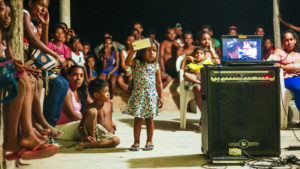
‘…but if we’re not careful we’ll stop being human beings and turn into robots.’ Pataxó indigenous community, Pequi Village (Laryssa Machada)
Thydêwá: Dialogue, for the future
Thydêwá was founded in 2002 to stimulate dialogue, and encounters, between indigenous and non-indigenous people. “We’re all part of the same planet – Gaia”, Gerlic states, “– and we need to find ways for us all to live together in our shared home.” Thydêwá is certainly about empowering indigenous populations through IT, then, but above all, it’s about communication to promote healthy co-existence. Facilitating dialogue via new technologies means that these cut-off and/or marginalised communities can interact with the non-indigenous community, in order to get their voices heard and promote wellbeing for everyone.
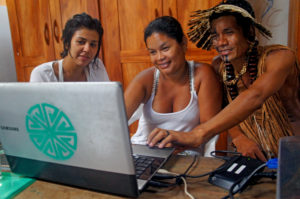
In 2009, Thydêwá set up a new cultural centre that linked together all the other cultural centres located in individual communities. The indigenous people nicknamed this space the “DIGITAL ROUNDHOUSE” and they use it to produce art and other forms of communication to defend their life in harmony with Mother Earth. Oca Digital (Sebastián Gerlic)
Gerlic explains the changing way that the Brazilian mainstream interacts with Brazil’s indigenous peoples. “At the beginning of the twenty-first century, they were surviving, but were largely invisible to mainstream society.” And where they weren’t invisible, there was significant prejudice expressed towards them: “Powerful voices in agribusiness only ever referred to indigenous people as a barrier to progress. Many set up mafia groups to threaten, criminalise, torture and kill indigenous people who were simply fighting for their rights.”
2001: Finding an indigenous voice
Initially, Thydêwá worked in partnership with four indigenous communities on a project to overcome the general ignorance surrounding them, as well as the desire by others, such as anthropologists, to speak on their behalf. The NGO worked to facilitate the indigenous communities having their own voices and their own concerns heard by others. This first project, called Índios na visão dos índios (Indigenous people through their own eyes), was a book series made up of photos indigenous people had taken of each other, and writings about their communities.
2003: Being heard
More books followed the first series. By 2003, seven books had been published, and more attention was being attracted to the indigenous cause. “They were even starting to get coverage on television where they denounced violent attacks, or the lack of respect for the rights that they have enshrined in the 1988 Brazilian Constitution and in international conventions,” Gerlic notes.
“50% of Brazilian indigenous people don’t have any land, and those that do have their territory demarcated have a permanent battle with logging and mining companies that seek to exploit the natural resources, as well as the indigenous people themselves.”
Fight for rights: a strengthened resolve
“Through our books and the growing media attention that they created, Thydêwá strengthened the resolve of indigenous people to make themselves heard,” Gerlic explains. The communities were keen to loudly articulate their denunciation of violent aggression – but they also wanted to draw peoples’ attention to the richness and beauty of their cultures, which are still very much alive and kicking in the present day, against all the odds. Gerlic goes on to tell me that “we laid the groundwork for the rest of the world to realise that indigenous people really want to interact and cooperate with others who share the same values as them: the desire for peaceful, respectful coexistence with others and respect for Mother Nature.”
2004: into the digital domain
Lower levels of technological connectivity are seen in particular communities – specifically, amongst racial and ethnic minorities, women, people with lower incomes, rural residents and those with less formal education. This is dubbed the “Digital Divide”. The communities that Thydêwá works with fall into most of these categories simultaneously. And thus the NGO chose to fight the digital divide, arming indigenous peoples with the knowledge and technologies to develop a presence online. Getting them online, Gerlic states,
“simultaneously overcomes the tyranny of distance in terms of access to education, information and political representation, as well as uses the new public sphere of the net to encourage intercultural communication that will help reduce social prejudices.”
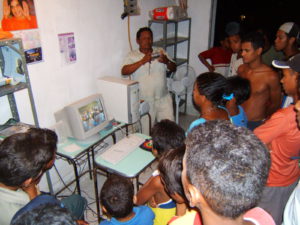
The Kariri-Xocó Cultural Centre on the day that internet first arrived in their community, 15 April 2004. (Thydêwá archives)
The seven communities that had made the initial books re-united in 2004 for a new idea: an online network, which came to be known as Índios On-line. The portal enabled people from these communities to speak with each other, and it also allowed them to connect to people across the rest of the world. It was a huge success from 2004 to about 2011. However, by 2012 many participants had moved over to more common social networks, “dropping their digital activism in favour of simply “liking” things on Facebook.”
Photographs offer the indigenous people a way of providing proof of what’s going on in their communities. And they use new information and communication technologies to achieve real social change. Antxohã Tupinambá (Sebastián Gerlic)
This doesn’t mean the Digital Divide is no more, however – there are other exclusions that are still to be tackled. Gerlic explains that “after ten years of Índios On-Line, a special group was born from within it; an Indigenous Women’s Network called Pelas Mulheres Indígenas.” This focuses on “raising women’s voices specifically, because women had had a lesser level of participation in Índios On-line, and in virtually every other aspect of society, too.”
Online interaction between indigenous and non-indigenous peoples both within Brazil and internationally is vital, on both sides. Indigenous communities are on the frontline of exploitation, in terms of transnational capitalism, and its determination to extract value from both people and environment.
“Their traditional knowledge about medicinal plants is stolen and the natural world that they inhabit and live in harmony with is exploited to the point of exhaustion. So they use the internet to call for help internationally; to save themselves, but also to save the planet for all of us. They also know that where the Brazilian government does not uphold their rights, they can appeal to the international community to support them and limit the impunity of their own government.”
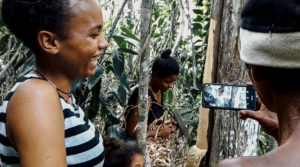
Many indigenous people use smartphones to document their cultural heritage, their practices and their knowledge. Tupinambá de Olivença indigenous community (Laryssa Machada)
But the Digital Divide is pernicious. Just because the Internet gives everyone a voice, doesn’t mean everyone gets their volume turned up high. “Are indigenous voices as easy to find and hear online as those of big companies such as Nestlé or Coca Cola, whose plants divert water away from indigenous communities, for example? Indigenous perspectives still have to fight to be heard, no matter how many projects we run to improve connectivity or digital literacy.”
Now: Progress and problems
Thydêwá’s work continues, and they still use new technologies as part of their toolkit to promote dialogue and encounters, both on- and offline. Gerlic outlines their most recent project: “Memoria Viva (Living Memory) seeks to overcome the generational divide where young people and their older relatives struggle to find anything in common. We address this by actively encouraging elders to share traditional knowledge with the younger community members, and in exchange the youth share their knowledge of new technologies with their elders.”
While Thydêwá has helped a number of indigenous communities to get online, the Brazilian government, under the Lula administration particularly, also began to roll out the idea of digital dialogue and access. Inspired by projects such as Índios On-line, “approximately 50 indigenous communities in Brazil now have ‘Pontos de Cultura Indígenas’ (Indigenous Cultural Centres) with access to the internet.” The idea behind it? “To promote autonomy, empowerment and citizenship amongst indigenous people”. But barely a decade later, all progress stopped. “The government stopped supporting the programme and the majority of indigenous people in Brazil are still without a way to access information online and thus participate in the Information Society.”
The government’s standstill appears, in fact, to now be changing course, and heading off in the wrong direction. Gerlic goes as far as to say that “right now, the Brazilian government’s policy seems to be far more focused on increasing digital inequality, through programmes to privatise all aspects of these new technologies”. Some communities still receive government assistance to get online, but, Gerlic explains, “all this amounts to is an antenna per village” – an antenna which cannot even cope with “10% of the demand for information to complete homework tasks from the community’s school children.” In other cases, hardware was supplied, “but no training was given in how to set it up and use it and it has hence gone to waste.”
Of course Internet access can be a massive stepping-stone toward inclusion, integration and education. “I think that ‘digital inclusion’ should be considered a fundamental human right in this day and age”, Gerlic says. “The Brazilian government should ensure that all state-run schools have free, open and high-speed internet, 365 days of the year, and they should make it a priority to get rural schools online first. They should also set up a programme to allow schools to access ‘support’ in the use of new technologies from NGOs and/or universities, so that they’re employed critically and in support of the community and the environment.”
All for the good? The darker side of digital
Digital technologies have been a valuable means of amplification for indigenous communities’ voices in the national and international forum. But, as Gerlic suggests, digital technologies are not necessarily a source of empowerment:
“At Thydêwá, we knew that digital technologies were finding their way into the hands of indigenous people, by hook or by crook, and they were turning up complete with their manufacturers’ ideologies embedded in their design.”
Those ideologies include materialism; a distinctly Western trap for these communities whose relationship with the earth and its resources has thus far been a much more respectful, and mutually beneficial, one. Digital technologies “encourage materialism, the acceptance of ‘built-in obsolescence’ and dependency on the technological know-how of the manufacturers,” Gerlic continues, “so that the user is locked into a costly system of consumption.”
There is also the more tangible, and human, cost of technology.
“Using new technologies such as smartphones also means accepting the business ethics of the manufacturers, which can include environmental damage in order to extract the minerals needed for their manufacture and slave labour to assemble them. It also means the sacrifice of significant amounts of a person’s privacy and an increase in surveillance, both by governments and mega-corporations.”
For Thydêwá, then, the objective is “to ensure that indigenous people are a bit more aware of what using these technologies implies, and to empower them to resist the worst aspects of ‘the System’.” Whilst the internet allows the communities access to information (such as what their government is investing in, and what corruption is going on), and amplifies their voices, it needs to be used with critical awareness so that they don’t fall into to the sorts of materialist traps which have made non-indigenous populations so dangerous to their survival.
“The internet is a weapon with which they can fight for their rights, gather information and have their say. Nowadays, indigenous people take photos and use them to defend themselves or prove the illegal actions of others. They take photographs of the theft of mineral deposits from within their territories; of pollution and the abuse of power of the police and military when they attack them. They appropriate new information and communication technologies in order to mobilise international support networks when they suffer serious human rights abuses. And they also use technology to make art, to record the beauty of the natural world, tell stories, give their opinions, and interact with people all over the world, in the hope that together we will be able to transform society to benefit all equally.”
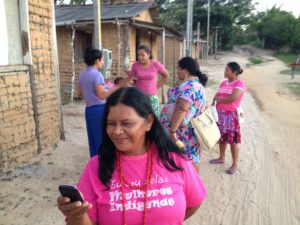
Indigenous women are working to establish a support network across all the communities, with a view to diminishing macho behaviour, discrimination against women and gender violence. Chief Arian Pataxó walking around Itapuã Village, in Tupinambá de Olivença territory. (Sebastián Gerlic)
Indigenous peoples are rightly cautious of the addictive pull of connectivity. In Thydêwá at least, “indigenous and non-indigenous people alike are all trying to resist ‘digital imperialism’ (albeit with digital tools), and reinvent life.” Informed access to digital technologies, then, has certainly been a weapon in the arsenal of Brazil’s indigenous communities in their fight for their basic human rights. “It’s undeniable that the internet has helped some of the most marginalised people in the world to be just a little bit less marginalised,” Gerlic states.
“Today, indigenous people can get online and they can use blogs to share community knowledge, or email the government to lobby for better services. However, even when indigenous people can have their say online, it still doesn’t leave us with a level playing field. There is still a huge imbalance of power online, where those in power manipulate the system, skewing the flow of information to their own advantage, and spreading false information about indigenous people so that they’re still not being heard properly.”
The fight is not over, then; indigenous ways of life in Brazil continue to be questioned, impinged upon and threatened, on a daily basis. And the world risks not only losing these communities, but also their art, their perspective, and a way of life which evidences sanity with regard to the earth’s rich resources, and sanctity in their treatment of them. Thydêwá’s members are determined to make careful use of these “imperialist” digital tools to shout louder than ever before.
[1] Facilitated, translated and edited by Thea Pitman

